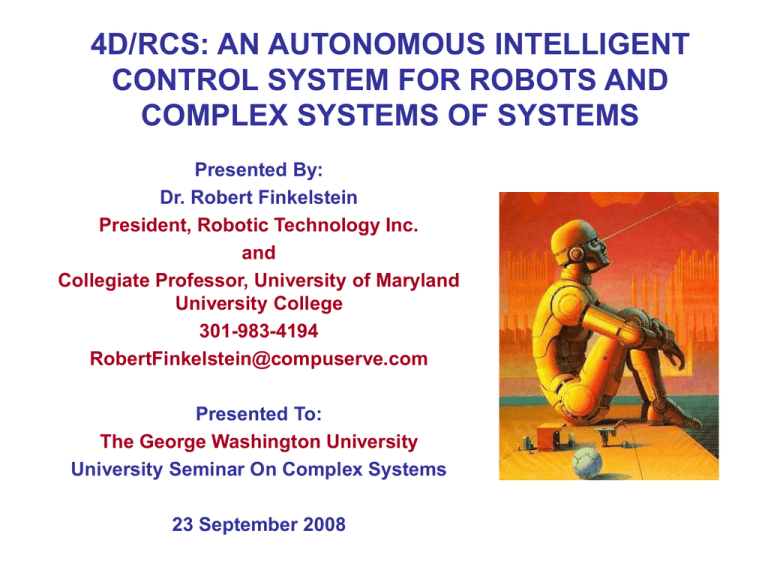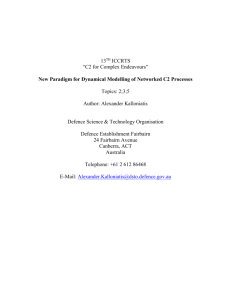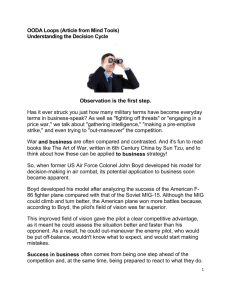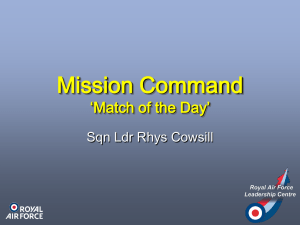4D/RCS: AN AUTONOMOUS INTELLIGENT CONTROL SYSTEM
advertisement

4D/RCS: AN AUTONOMOUS INTELLIGENT CONTROL SYSTEM FOR ROBOTS AND COMPLEX SYSTEMS OF SYSTEMS Presented By: Dr. Robert Finkelstein President, Robotic Technology Inc. and Collegiate Professor, University of Maryland University College 301-983-4194 RobertFinkelstein@compuserve.com Presented To: The George Washington University University Seminar On Complex Systems 23 September 2008 PURPOSE OF PRESENTATION Describe an autonomous intelligent control system architecture Suitable for controlling individual or collective robots or complex systems of systems For military or civil applications 4D/RCS: 3 dimensions of space and 1 of time in a Real-time Control System (RCS) Developed over last 30 years by the Intelligent Systems Division (ISD) of the National Institute of Standards and Technology (NIST), an agency of the U.S. Department of Commerce More than $125 million invested by U.S. government, not including an additional $250 million for application as Autonomous Navigation System (ANS) in Army’s Future Combat System (FCS) BACKGROUND 4D/RCS Originated in early work by Dr. James Albus on neuro-physiological models and adaptive neural networks Originally designed to control manufacturing facilities, where the entire manufacturing facility might be considered to be a distributed robot with strategic planning at the top levels of the control hierarchy, work cells in the middle levels, individual machine tools at the lower levels, and individual servos at the bottom level Since modified and adapted for robotic vehicles, especially for various robotic ground vehicles where it was successfully demonstrated driving robotic ground vehicles autonomously on roads and cross-country EXTENSION TO COMPLEX SYSTEMS 4D/RCS A framework in which sensors, sensor processing, databases, computer models, and machine controls may be linked and operated such that the system behaves as if it were intelligent Can be designed to permeate a system or a system of systems, where the systems may be fully autonomous, or human supervisors can interface with the 4D/RCS in a number of ways via communications and command and control links Can also interact with distant databases, machines, and control centers Can serve as a decision tool for decision-makers, for complex systems of systems EXTENSION: FUTURE COMBAT SYSTEM (FCS) Estimated Development Cost By 2014: $250 Billion WHAT ARE ARCHITECTURES AND SYSTEMS? Architecture: The fundamental organization of a system embodied in its components, their relationships to each other, and to the environment, and the principles guiding its design and evolution [IEEE Standard 14712000] System: A set of variables selected by an observer, where a variable may be defined as a measurable quantity which at every instant has a definite numerical value - a quantity which, for example, can be represented by a measuring device such as a ruler or a gas gauge (or a subjective evaluation) Anything that has parts (an observer may define a system to be whatever is convenient for a particular purpose) WHAT ARE COMPLEX AND CYBERNETIC SYSTEMS? Complex system: System in which there are many variables and interconnections among variables (called detail complexity), or where cause and effect are not close in time and space and obvious interventions do not produce the expected outcomes (called dynamic complexity) System with the potential to evolve over time, with subsystems having emergent properties that can be described only at higher levels in the system than those of the subsystems Cybernetic system Systems which have negative feedback and are therefore controllable; often consisting of organisms and machines INTELLIGENCE AND AUTONOMY The question is not how smart a robot should be, but how dumb can it be and still do its job? WHAT IS INTELLIGENCE? Pragmatic definition of intelligence: an intelligent system is a system with the ability to act appropriately (or make an appropriate choice or decision) in an uncertain environment An appropriate action (or choice) is that which maximizes the probability of successfully achieving the mission goals (or the purpose of the system) Intelligence need not be at the human level WHAT IS INTELLIGENCE? Three useful corollary definitions of intelligence: Reactive intelligence (adaptation) Based on an autonomic sense-act modality Ability of the system to make an appropriate choice in response to an immediate environmental stimulus (i.e., a threat or opportunity) Example: it is raining and the system is getting wet, so it seeks shelter Predictive intelligence (learning) Based on memory Ability to make an appropriate choice for events that have not yet occurred but which are based on prior events Example: it is very cloudy and the system infers that it will likely rain soon, so it decides to seek shelter before it rains Creative intelligence (invention) Based on learning and the ability to cognitively model and simulate Ability to make appropriate choices about events which have not yet been experienced Example, it takes too much time and energy for the system to seek shelter every time it rains or threatens to rain, so it invent an umbrella to shield it from the rain (the system can imagine that the umbrella, which never before existed, will protect it from the rain) WHAT IS LEARNING? Learning: the acquisition of knowledge, skill, ability, or understanding by study, instruction, or experience, as evidenced by achieving growing success (improved behavior), with respect to suitable metrics, in a fixed environment Learning takes place when the system’s behavior increases the efficiency with which data, information, and knowledge is processed so that desirable states are reached, errors avoided, or a portion of the system’s environment is controlled WHAT IS ADAPTATION? Adaptation: A change in behavior (or structure) in response to a changed environment Able to maintain critical or essential variables within physical (or physiological) limits (e.g., homeostasis) Where the changed behavior (or structure) increases the probability that the system can achieve its function or purpose (e.g., maintain homeostasis) by adjusting to the new or changed environment Learning – fixed environment Adaptation – changed environment WHAT IS WISDOM? Many projects to develop machine learning and intelligence – but none yet for machine wisdom The original meaning of the word philosophy is “love of (or search for) wisdom” A perception of the relativity and relationships among things An awareness of wholeness that does not lose sight of particularity or concreteness, or of the intricacies of interrelationships The ability to filter the inessential from the essential The ability to recognize that which is significant amongst the detail – to see the forest as well as the trees Knowledge involves aggregating facts; wisdom lies in disaggregating facts AUTONOMOUS INTELLIGENCE: DOD GOAL WHAT IS AUTONOMY? Still being defined ALFUS (Autonomy Levels For Unmanned Systems) Working Group Managed by the Army Research Lab (ARL) and the National Institute of Standards and Technology (NIST) Since 2003, meets at various U.S. locations WHAT IS AUTONOMY? ALFUS: Focusing on three key variables: Mission Complexity, Environmental Difficulty, and Human Interface EXAMPLE AUTONOMY TAXONOMY (ONR UCAV PROGRAM 2000) Level 0 1 Name Human Operated Human Assisted 2 Human Delegated 3 Human Supervised 4 Mixed Initiative 5 Fully Autonomous Description All activity within the system is the direct result of human-initiated control inputs. The system has no autonomous control of its environment, although it may have information-only responses to sensed data. The system can perform activity in parallel with human input, acting to augment the ability of the human to perform the desired activity, but has no ability to act without accompanying human input The system can perform limited control activity on a delegated basis. This level encompasses low-level automation that must be activated or deactivated by a human input and act in mutual exclusion with human operation. The system can perform a wide variety of activities given top-level permissions or direction by a human. The system provides sufficient insight into its internal operations and behaviors that it can be understood by its human supervisor and appropriately Both the human and the system can initiate behaviors based on sensed data. The system can coordinate its behavior with the human's behaviors both explicitly and implicitly. The human can understand the behaviors of the system in the same way that he und The system requires no human intervention to perform any of its designed activities across all planned ranges of environmental conditions. Example Automobile automatic transmission and anti-skid brakes. Automatic flight controls, engine controls EXAMPLE AUTONOMY TAXONOMY (BOEING) Six levels (four Regions) stated in terms of degree of operator interaction (adopted from the Naval Studies Board report on ONR UCAV Program, Summer 2000) Region Requiring Intelligent Aiding Required Operator Control Power per Vehicle Manual Automated Semi-Autonomous Min Level For Mixed-Initiative Control 100% Human Min Level For Supervised Control TUAV SAS, CAS 1. Human Operated 2. Human Assisted UCAV 100% Machine UCAV-N Design Space VTUAV Min Level for Teleoperated Control Autonomous Auto Pilots, Auto IFF Automatic Modes Auto Route, Auto Target Track, Auto Land, Scripted Skills 3. Human Delegated 4. Human Supervised Level of Autonomy per Vehicle Dynamic Re-plan, Auto Survival Response, Contingency Response, Target of Opportunity, Multi-Agent Collaboration, Mixed-Initiative Behaviors 5. Mixed Initiative 6. Fully Autonomous EXAMPLE AUTONOMY TAXONOMY (NORTHROP-GRUMMAN) High Autonomy Human-System Interaction Approach • Computer Performs All Aspects of Decision-Making and Adaptive Operations Informs Operator After the Fact, if Required, per Preplanned Criteria or Operator Request Sheridan 9-10 • Computer Generates Decision Alternatives and Autonomous Operations a Preferred Option to Execute and Informs Operator in Time for Intervention • Computer Generates Decision Alternatives Aided Operations and Recommends One to Carry Out – but Only With Operator Approval. Operator May Select Alternative Option • Computer Executes Commands Initiated by Deliberate Operations Low Autonomy UCAV System Level of Autonomy Operator. (Computer May Provide and/or Recommend Decision Alternatives to Operator) EXAMPLE AUTONOMY TAXONOMY System offers no assistance – operator must do everything System offers a complete set of action alternatives to operator System narrows the action alternatives to a few System suggests a selection, and System executes a selection if operator approves, or System allows operator a restricted time to veto before automatic execution, or 7) System executes automatically, then necessarily informs operator, or 8) System informs operator after execution only if operator asks, or 9) System informs operator after execution - if system decides to 10) System decides everything and acts autonomously, essentially ignoring the human 1) 2) 3) 4) 5) 6) Control System Architecture Software Tools Computer Control Systems Sensory Perception Databases & World Modeling Internal & External Communications Mobility Hardware Architecture Internal & External Sensors Robotic System Sensor Systems Sensor Processing Sensor Architecture Platform & Mobility Design Functional Diagram Structural Dynamics/Kinematics Effector Systems Weapons Systems Manipulators & End Effectors Propulsion Systems Human Interface Systems Controls & Displays Testing Maintenance & Support Training AUTONOMOUS INTELLIGENT CONTROL Many prospective autonomous intelligent control system architectures NIST 4D/RCS most advanced 30 years development and $100 million invested Demos I, II, III, and many other successful demonstrations Used by GDRS for FCS Autonomous Navigation System (ANS) BASIC INTELLIGENT SYSTEM OODA LOOP Orient Perception Observe Sensing Decide World Model Goal Behavior internal external Real World Act Action Perception establishes correspondence between internal world model and external real world Behavior uses world model to generate action to achieve goals 4D/RCS ARCHITECTURE Battalion Formation SPOODABG WM Platoon Formation SP WM Section Formation SP Objects of attention SP OODA Lines OODA SP WM BG OODA OODA Points BG SURROGATE PLATOON Plans for next 2 hours WM BG SURROGATE SECTION WM BG VEHICLE OODA Communication SP WM BG SP WM BG Plans for next 24 hours OODA OODA Attention Surfaces SURROGATE BATTALION OODA Locomotion SP WM BG SP WM BG SP WM BG SP WM BG SP WM BG SP WM BG SP WM BG SENSORS OODA Mission Package OODA OODA OODA Plans for next 10 minutes Tasks relative to nearby objects Plans for next 50 seconds Task to be done on objects of attention SUBSYSTEM 5 second plans Subtask on object surface Obstacle-free paths OODA OODA SP WM BG SP WM BG OODA OODA OODA SP WM BG SP WM BG SP WM BG AND ACTUATORS PRIMITIVE 0.5 second plans Steering, velocity OODA SP WM BG SERVO 0.05 second plans Actuator output OPERATOR INTERFACE OODA A 4D/RCS COMPUTATIONAL NODE 4D/RCS: KNOWLEDGE IS CENTRAL A 4D/RCS COMPUTATIONAL NODE Planning Loop SENSORY PROCESSING WORLD MODELING SIMULATOR PREDICTOR Recognize Filter Compute Group Window Tentative Plans VALUE JUDGMENT Agent1 Task Command Input Status 4D/RCS node BEHAVIOR GENERATION Task Decomposition PLANNER cost benefit Planning Expected Results KD Images Maps Entities Events States Attributes PLAN PLAN PLAN EXECUTOR EXECUTOR EXECUTOR Feedback Feedback Loop Subtask Subtask Command Command Output Output Status Status Subtask Command Output Status BG BG PLANNER BG PLANNER PLANNER Plan Plan Plan Plan Plan Plan Plan Plan Plan EX EX EX EX EX EX EX EX EX Execution 4D/RCS ARCHITECTURE Battalion Company Artillary Armor Logistics 5 hr plans replan every 25 min Platoon IndirectFire DirectFire AntiAir 1 hr plans replan every 5 min Section UAV C2 Manned C2 UGS C2 10 min plans replan every 1 min UARV UGV Scout Vehicle UAV Subsystem Primitive Servo 24 hr plans replan every 2 hr Battalion HQ Pan RSTA Gaze Tilt Communications Iris Focus Mobility Weapons Gaze Select Pan Sensors and Actuators 1 min plans replan every 5 s Tilt 5 s plans replan every 500 ms Driver 500 ms plans replan every 50 ms Speed Heading 50 ms plans output every 5 ms CONTROL ARCHITECTURES Three major types: hierarchical (deliberative); reactive; hybrid (deliberative/reactive) SENSE Hierarchical Reactive SENSE PLAN ACT PLAN Hybrid SENSE ACT ACT CONTROL ARCHITECTURES In addition to deliberative and reactive behaviors, an intelligent control system could also be reflective Able to monitor and alter its behavior (i.e., its critical variables) to better adapt A meta-control system controls the intelligent control system 4D/RCS DOCUMENTATION 4D/RCS Version 2.0 NIST Report, 2002 Engineering of Mind - Wiley, 2001 RCS Handbook – Wiley, 2001 Numerous journal articles, reports, and conference papers Extensive software library: http://www.isd.mel.nist.gov/projects/rcslib MOST RECENT BOOK: 2007







